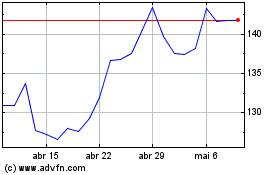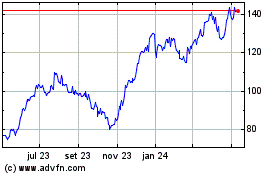By Anna Hirtenstein and Paul Vigna
The Dow Jones Industrial Average dropped 650 points Monday as
coronavirus cases surged, adding to worries about the economic
outlook after Congress and the White House failed to agree on a
much-anticipated fiscal stimulus deal.
Major indexes opened lower, and declines accelerated into the
afternoon. In the Dow -- which suffered its steepest one-day point
and percentage drop since Sept. 3 -- 29 of 30 stocks fell on the
day. All 11 sectors of the S&P 500 also suffered losses.
Among the biggest decliners were the travel and leisure stocks
that have come under the most pressure this year during the
pandemic. Royal Caribbean Group dropped 9.6%, United Airlines
Holdings fell 7% and Marriott International declined 5.6%.
"The ability to fight the virus further right now is very much
in question, and it's a political question," said Steven Wieting,
chief strategist at Citi Private Bank. It could be months before
anything gets done in Washington, and that's made investors
tentative, he said.
The Dow fell 650.19 points, or 2.3%, to 27685.38, paring a
early-afternoon loss of as much as 965 points. Apple was the only
stock in the index to finish the day in the green, rising a
penny.
The S&P 500 lost 64.42 points, or 1.9%, to 3400.97. The
Nasdaq Composite dropped 189.34 points, or 1.6%, to 11358.94. All
three indexes are down more than 5% from their records earlier this
year.
The average number of new coronavirus cases reported daily over
the past week reached an all-time high of 68,767 on Monday.
Scientists had been expecting cooler weather to lead to a second
wave of the disease, but the swell is coming earlier than many had
anticipated. That is prompting fresh concerns about tighter
lockdown restrictions and the effect on the economy.
"It's a worrying picture for sure," said David Stubbs, head of
investment strategy at J.P. Morgan Private Bank. "But we always
knew this recovery would be stop-start: We won't be truly moving
into the main part of a new cycle until the health-care issue
itself is dealt with."
Meanwhile, the chances of a stimulus package coming together
before the election next Tuesday are looking increasingly slim, and
the possibility, if President Trump is defeated, of no additional
relief coming before late January is rising. Democrats and White
House officials have blamed each other for the lack of
progress.
A selloff here isn't surprising, said Esty Dwek, head of global
market strategy at Natixis Investment Managers. Last week the
market was optimistic about stimulus aid, and this week those hopes
have been leveled somewhat.
Moreover, some polls suggest key Senate races are tightening,
Ms. Dwek said, cutting into expectations of a takeover that would
allow Democrats to pass an aggressive stimulus package after the
election. "The blue wave might not be as much of a given," she
said.
Historically, the week before a presidential election is good
for stocks. Since 1928, the market has usually risen in the last
full week before the contest. The S&P 500 has been up in 70% of
those weeks, according to Dow Jones Market Data. The gains are even
more frequent if measured from the Tuesday before the election to
Election Day. The index has risen in 91% of those instances.
Investors are also still tuned in to third-quarter earnings
season. A heavy calendar this week includes Microsoft, Caterpillar,
Apple, Amazon.com, 3M, ConocoPhillips and Alphabet.
The critical element isn't necessarily the results themselves,
said Fawad Razaqzada, an analyst at ThinkMarkets, but the corporate
outlooks for the next few quarters. If executives start pointing to
weaker earnings growth and a slowing economy, it could cut into the
market's momentum, he said. "People are generally optimistic about
the future," he said. "This might be a reality check."
Corporate earnings are expected to turn a corner in the current
reporting season. Although profits are still expected to fall
sharply from a year earlier, analysts project a rebound from the
second quarter and a return to growth in 2021.
The beaten-down energy sector was the weakest performer in the
S&P 500 Monday, falling 3.5%. The industrials, materials,
communications services, financials and information technology
groups also fell more than 2%. Utilities were a relative bright
spot, dropping less than 0.1%.
Elsewhere, the pan-continental Stoxx Europe 600 retreated 1.8%,
led by a decline in German stocks. Coronavirus cases are
accelerating in Europe. France reported more than 52,000 new
infections Sunday, a daily high. Italy is trying to rein in the
spread with new rules, such as the mandatory closure of restaurants
and bars at 6 p.m. Spain declared a state of emergency, as it did
in March.
In Asia, most major equity benchmarks closed lower. China's
Shanghai Composite Index fell 0.8%. Markets in Hong Kong were
closed for a public holiday.
In other markets, U.S. crude oil futures fell 3.2% to $38.56 a
barrel. A cease-fire in Libya has led analysts to project the
country's output will reach 1 million barrels a day in the next
four weeks, up from about half a million a day, according to Bjarne
Schieldrop, chief commodities analyst at SEB. The rise in
coronavirus infections is also muting prospects for the economic
recovery and damping demand, he said.
In bond markets, the yield on the benchmark 10-year U.S.
Treasury note declined to 0.801%, from 0.840% Friday.
The WSJ Dollar Index, which measures the greenback against a
basket of currencies, added 0.3%.
Write to Anna Hirtenstein at anna.hirtenstein@wsj.com and Paul
Vigna at paul.vigna@wsj.com
(END) Dow Jones Newswires
October 26, 2020 17:24 ET (21:24 GMT)
Copyright (c) 2020 Dow Jones & Company, Inc.
Royal Caribbean (NYSE:RCL)
Gráfico Histórico do Ativo
De Mar 2024 até Abr 2024

Royal Caribbean (NYSE:RCL)
Gráfico Histórico do Ativo
De Abr 2023 até Abr 2024
